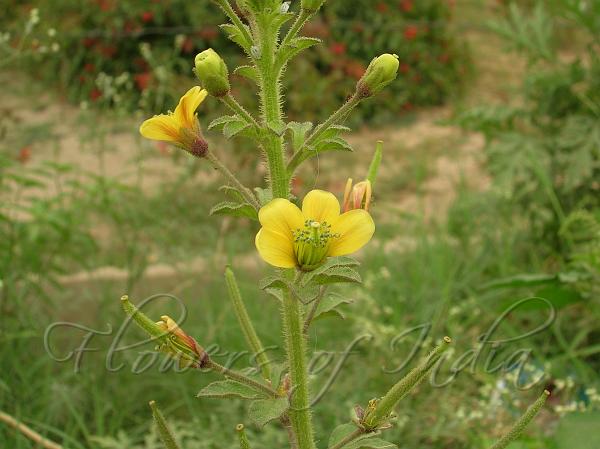|
| Asian Spider Flower |
|

|

| File size | 640852 |
| Original date | 6/13/06 11:19 AM |
| Resolution | 2048 x 1536 |
| Flash | Flash did not fire, auto |
| Focal length | 8.0mm |
| Exposure time | 1/173s |
| Aperture | 5.5 |
| Focus Distance | |
| Metering Mode | Partial |
| Camera make | NIKON |
| Camera model | E3700 |
| Sensor type |
|
|
|
Photo: |
Botanical name: Cleome viscosa Family: Cleomaceae (Spider Flower family)
Synonyms: Polanisia viscosa
Synonyms: Polanisia viscosa
Asian spider flower is a usually tall annual herb, up to a meter high,
more or less hairy with glandular and eglandular hairs. Leaves are
digitately compound, with 3-5 leaflets. Leaflets are obovate, elliptic-oblong,
very variable in size, often 2-4 cm long, 1.5-2.5 cm broad, middle one
largest; leaf-stalk up to 5 cm long. Racemes elongated, up to 30 cm
long, with corymbose flowers at the top and elongated mature fruits
below, bracteate. Flowers 1-1.5 cm across, whitish or yellowish;
flower-stalks 0.6-2 cm long; bracts leaf-like. Sepals oblong-lanceshaped,
3-4 mm long, 1-2 mm wide, glandular-velvet-hairy. Petals 8-15 mm long,
2-4 mm broad, oblong-obovate. Stamens are 10-12,
not exceeding the petals. Pods are 3-7.5 cm long, 3-5 mm
broad, linear-oblong, erect, tapering at both ends, glandular-velvet-hairy.
Asian spider flower is found in Tropical & Subtropical Asia,
Africa and Australia, including the Himalayas.
Medicinal uses: The leaves are diaphoretic, rubefacient and
vesicant. They are used as an external application to wounds and ulcers.
The juice of the leaves has been used to relieve earache. The seeds are
anthelmintic, carminative, rubefacient and vesicant. The seed contains
0.1% viscosic acid and 0.04% viscosin.
The leaves are diaphoretic, rubefacient and
vesicant. They are used as an external application to wounds and ulcers.
The juice of the leaves has been used to relieve earache. The seeds are
anthelmintic, carminative, rubefacient and vesicant. The seed contains
0.1% viscosic acid and 0.04% viscosin.
Medicinal uses:
 The leaves are diaphoretic, rubefacient and
vesicant. They are used as an external application to wounds and ulcers.
The juice of the leaves has been used to relieve earache. The seeds are
anthelmintic, carminative, rubefacient and vesicant. The seed contains
0.1% viscosic acid and 0.04% viscosin.
The leaves are diaphoretic, rubefacient and
vesicant. They are used as an external application to wounds and ulcers.
The juice of the leaves has been used to relieve earache. The seeds are
anthelmintic, carminative, rubefacient and vesicant. The seed contains
0.1% viscosic acid and 0.04% viscosin.| Identification credit: Pravin Kawale, L.P.A. Reddy | Photographed in Delhi and Karnataka. |
• Is this flower misidentified? If yes,